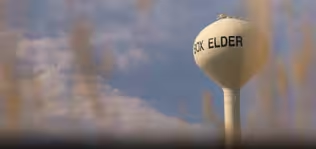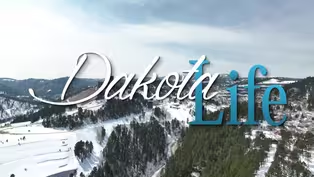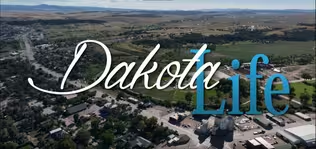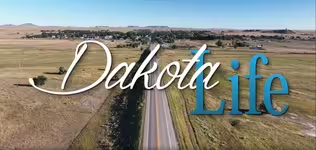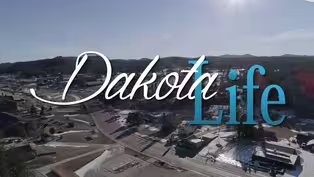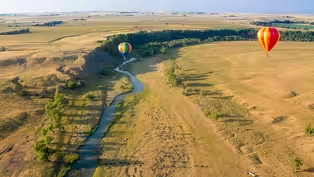Dakota Life
Greetings from Hill City
Season 26 Episode 1 | 25m 49sVideo has Closed Captions
Visit an artist coop, the state railroad museum, gardening enthusiasts, and an annual film
Hill City blossoms with stories about the annual Black Hills Film Festival, the ArtForms Gallery, an artist coop, a visit to the South Dakota Railroad Museum, and a visit with the gardening enthusiasts of the Hill City Evergreen Garden Club.
Problems playing video? | Closed Captioning Feedback
Problems playing video? | Closed Captioning Feedback
Dakota Life is a local public television program presented by SDPB
Support Dakota Life with a gift to the Friends of Public Broadcasting
Dakota Life
Greetings from Hill City
Season 26 Episode 1 | 25m 49sVideo has Closed Captions
Hill City blossoms with stories about the annual Black Hills Film Festival, the ArtForms Gallery, an artist coop, a visit to the South Dakota Railroad Museum, and a visit with the gardening enthusiasts of the Hill City Evergreen Garden Club.
Problems playing video? | Closed Captioning Feedback
How to Watch Dakota Life
Dakota Life is available to stream on pbs.org and the free PBS App, available on iPhone, Apple TV, Android TV, Android smartphones, Amazon Fire TV, Amazon Fire Tablet, Roku, Samsung Smart TV, and Vizio.
Providing Support for PBS.org
Learn Moreabout PBS online sponsorshipMore from This Collection
Dakota Life stories from towns in western South Dakota
Video has Closed Captions
The community of Box Elder is one of the fastest-growing cities in South Dakota. (28m 52s)
Video has Closed Captions
Greetings from the ranching community of Union Center. (27m 53s)
Video has Closed Captions
Dakota Life visits Custer and the surrounding area. (24m 56s)
Dakota Life: Postcard from Hot Springs
Video has Closed Captions
Dakota Life: Postcard from Hot Springs (29m 49s)
Providing Support for PBS.org
Learn Moreabout PBS online sponsorship- [Announcer] This is a production of South Dakota Public Broadcasting.
(uplifting music) - Scientists have determined human habitation in the Black Hills goes as far back as 11,500 BC.
It's over 13,000 years ago.
The Arikira arrived in the 14th century, followed by other native tribes, the Cheyenne, Crow, Kiowa, Arapaho, and then the Lakota in the 18th century.
The traditional Lakota origin story tells of the first bison and humans emerging from nearby Wind Cave.
They call this area Paha Sapa, the hills are black, and it's a place of spiritual and cultural significance.
The discovery of gold brought a mass influx of settlers and prospectors.
There was fierce resistance to the intrusion on the land, culminating in the battle of the Little Bighorn in 1876.
Following that conflict, the US government seized the Black Hills from the Lakota, and one of the settlements established that same year was Hill City.
It's the oldest town in Pennington County, and the second oldest in all of the Black Hills.
It was a settlement in a scenic valley beside Spring Creek, and its centralized location earned at the nickname the Heart of the Hills.
About that same time, there was an even richer gold strike near Deadwood, and that sent prospectors off to the Northern Black Hills, turning Hill City into a virtual ghost town.
It was the discovery of tin in 1883 that revitalized Hill City.
15 saloons sprang up to serve the thousands of new miners.
The atmosphere led one observer to call the community a town with a church on each end and a mile of hell in between.
The Harney Peak Hotel was also established.
It provided a luxurious getaway for visiting businessmen.
Today, the building still stands in its original location, and it's the home of the Alpine Inn.
The surrounding retail area includes a variety of shopping, museums, attractions, and a thriving art scene too.
It's all here for you to enjoy in the heart of the hills.
Welcome to "Dakota Life," and greetings from Hill City.
(cheerful music) - [Announcer] This program is made possible with support from our members, and by South Dakota Railroad Museum, educating the public on the railroad companies that have served South Dakota from 1872 to the present time through educational experiences, memorabilia and collections.
And by the 1880 Train, giving visitors to the Black Hills a historic ride on the rails, a 20 mile round trip excursion between Hill City and Keystone, entertaining guests since 1957.
See you trackside in Hill City.
- The Chicago, Burlington and Quincy Railroad reached Hill City in 1893.
Not long after, a spur called the Black Hills Central Line was extended to Keystone.
Rail services evolved through the years, but was revitalized in 1957 when the Black Hills Central Railroad began operating a tourist passenger train on that spur to keystone.
We know it today as the 1880 Train.
Then there was the Black Hills High Line.
It offered passenger service from Edgemont in the Southern Hills through Hill City, and all the way to Deadwood.
But that service was discontinued in 1949, and the rail line was abandoned in 1983.
But today, all 109 miles of the High Line has become the popular George S. Nicholson Trail.
Coming up, we're gonna meet gardeners with a passion for keeping Hill City beautiful.
We'll also visit an art co-op that features homegrown talent, and we'll learn about a new platform for emerging independent film artists.
But first, let's get back to that topic of railroads.
Trains have shaped South Dakota for over 150 years.
Passenger service has disappeared over much of the state, but you could still ride the train in Hill City.
And because of that, it was an easy choice to also make Hill City the site for the South Dakota State Railroad Museum.
(soothing music) - Nobody else does this.
We have this living, breathing piece of history that we get to teach people about, and entertain them while we're educating 'em about railroads.
- [Narrator] Meg Water's father, Bob, bought the Black Hills Central Railroad in 1990.
They've turned it into an experience you know today as the 1880 Train.
(train whistle blares) But Bob Water was also passionate about history.
- My father always believed that there needed to be a place for people that had railroad collections and railroad stories that were from South Dakota, and he strongly felt that there needed to be a repository for all of these stories in collections.
- [Narrator] We also want to talk about the museum.
I want to make sure that we don't go down the wrong track.
- Here we go, here we go.
Ferroequinologist, Latin for-- (train whistle blares) the study of the iron horse.
- [Narrator] It's a real word, and Rick Mills is one.
He's fascinated with trains his whole life, and he writes books about them.
He was the obvious choice to help start and be the director of the museum.
- We started out with the educational aspects of it.
We came up with this eight by 75 foot timeline mural that we put on the walls here.
That was one of the first things that was installed.
And that became the basis of all of our educational pursuits.
But also we put in things like quotes from General Sherman about the extinction of the Plains tribes.
We put in things from Red Cloud and comments about why they wanted to keep the homesteaders and the railroads out of the buffalo hunting country of west and north of the Black Hills.
Guess what, not everything in history is pretty.
And we need to show folks what was in context in that era.
- Along with the stories of the railroads' different impacts across the state, the museum will show you the tools that it took to build and maintain lines in South Dakota, the uniform and trade of being a conductor.
It doesn't quite fit.
- It doesn't quite fit.
Well, I don't know what to do.
- [Narrator] And life in a caboose.
(camera shutter clicks) All with the help of staff and volunteers like Philip Pearson.
- What I enjoy doing is meeting, greeting, showing people around.
I'm a historian, showing people what we have and talking, finding out where they're from.
Very often, I can relate to railroad history in that area.
Four or five years ago, I had two gentlemen come in, one of 'em spoke broken English, one, not much English at all.
Turned out they were Russian locomotive engineers.
And their question was the difference between American diesel electric locomotives, and European, which is mostly diesel hydraulic.
It was an interesting conversation.
- It's been a work in progress, and thanks to Rick Mills, who knows more about railroads in South Dakota than anyone, and the people that have served on the board of the museum, it's really come together, and continues to need support as all museums do.
- There is so much more emotion and so many different things that railroaders and their families and people that are riding trains feel that railroads bring out in them.
They bring out so many different emotions.
(train whistle blares) - The Civilian Conservation Corps, or CCC, was a program established during the Depression.
It provided jobs for the unemployed, and promoted conservation in national parks and forests.
Hill City hosted a CCC camp from 1933 to 1942.
The workers here were involved in reforestation, fire prevention, and park maintenance.
They also built a number of buildings in this area that are still in use today.
The South Dakota Civilian Conservation Corps Museum is also here, and you'll find an amazing collection of photos, artifacts, and a roster of the men whose work is still relevant today.
There's also a connection to Hill City High School.
You see, in 1939, a wildfire broke out near here, and the CCC went to work on it.
Members of the Hill City basketball team and other community members all pitched in to help with that fire that had raged for three days.
The US Forest Service so appreciated that help that they allowed the high school to use their famous symbol, Smokey Bear, as the school mascot.
See, Hill City is now the only school in the country to be allowed that honor.
And Hill City is also the only school in the nation that's also allowed to have their graduation ceremony at Mount Rushmore.
There's another group here, right here in the heart of the Hills, that provides education, community service, and creates one of the most beautiful spots to visit.
- [Landen] The streets, tourist-filled.
The curbside gardens, pristine.
For the Hill City Evergreen Garden Club, beautification is a top priority.
(soothing guitar music) The club's Yard of the Month Award gives residents a reason to participate.
- The Garden Club inspires us and many others to join in their effort to make our community, to spiff it up and make it more appealing and attractive.
And so we're very fortunate to have such an active group in the Hill City community.
- [Landen] The club meets monthly to discuss its future plans for the city.
Club president Gail McKane says The group's appeal attracts members from far and wide.
- There are people from all across the United States as well as locals.
And this group is so special that we even have members from Rapid City and Custer come all the way to Hill City to be part of this group.
- [Landen] Through annual fundraisers like the wreath sale and flower show, the club impact stretches further than their gardens.
- Everything we do is for the community.
So our main priority is scholarships, and we've done that every year.
The flower show totally supports the Boys and Girls Club, and, you know, we've supported whatever endeavors or things that are needed that are going on within Hill City itself.
- [Landen] McCain believes the club's support of young people is helping to grow more than just flowers.
- We have incredibly intelligent kids here, and yes, it's not just encouraging them as gardeners, but encouraging them in life.
- [Landen] Those unassuming curbside gardens may just be the seeds for the future.
- Prior to humans arriving in the Black Hills, there's evidence of a lot of other life in this area, evidence in the form of fossils, bones and other artifacts.
From Hill City, The Black Hills Institute has had an impact on geology and paleontology around the world.
For nearly 50 years, they've been collecting and preparing fossils.
Their collection of both vertebrate and invertebrate fossils, along with minerals from this region is one of the finest.
The collection includes dinosaurs, including the largest compilation of Tyrannosaurus Rex fossils, along with an assortment of ammonites, cephalopods, mollusks, insects, plants and fish.
Their excavations have discovered dozens of new species, several new genera, and even a new family of fossils.
With so much activity, you may see Hill City as a bigger community than it really is.
But Hill City is still a small town.
And you see those values in the way that people support their neighbors, including the creative community.
For example, one of the challenges for many young artists is finding a place to network, to show and to sell their work.
Hill City has been working on that.
- Well, what's special about Art Forms, it's in Hill City, of course, right in the middle of the Black Hills.
So it's convenient.
We try to, one of our taglines is affordable art.
We try to have a variety of artwork at prices that the average person can afford.
And we have some beautiful, expensive pieces as well.
But some stuff that, refrigerator magnets, and paintings, and photography, and books, and pottery, and lights, and all kinds of good things that might appeal to a wide audience.
So that's what we're shooting for.
I think that's pretty unique in the Black Hills.
- It's just a wonderful gallery of the artisan here.
We cooperate together.
It's good harmony in here that works very well for all of us.
- A lot of our pieces are one of a kind, originals or prints thereof.
But yeah, I think that's one of the main reasons that they come here.
Our gallery also is very community minded.
- Now, the Black Hills inspire creativity, I think you can say, for myself, as well as many other artists and other media.
And we also are lucky to have a population coming here to see the attractions, see the beautiful Black Hills.
And so we have this rotating audience of people coming into the gallery.
We just had some folks in from France, as well as across the country.
So it's an awesome place to do creative work and also share it with other people from really all over the planet.
- It's kind of neat, I get to create a lot of different things that way.
So a lot of my artwork is recycled fence post, either cedar or pine fence posts from out in the woods and so on.
And so I get to create stuff from nature.
- I've been a member here for going on 25 years.
Not quite as long as the gallery's been open, but almost.
And it's just a wonderful group of people.
We get together and have meetings and support each other and learn from each other and share failures and successes, and it's really an awesome group to be part of.
It's been that way since the beginning and I hope it continues well into the future.
- Being one of the members is kind of nice, 'cause you only have to work 20 days a year.
If it's our own store, you'd have to be here everyday, and you wouldn't have time to be home to do your creative artwork.
- Well, art of all kinds, I think, lets the artist interpret their feelings and their values and what the world means to them through their eyes and share that with other people.
And it's really cool when you connect with somebody who, in my case, I do these then and now photos, and people seem to enjoy that as much as I do.
Looking back into history and standing on that place and realizing this historic event took place right on this spot as documented by this historic photo.
And so being able to share what you find interesting internally with others is a joy to me and for others as well.
- It's kind of nice, you get to visit a lot of people.
Get to see people from all over the world, and so get to talk to 'em, and you get to enjoy our artwork that we do.
- I couldn't do this otherwise.
We couldn't afford a space like this and pay the rent and the lights and electricity, everything, but collectively it's very, very doable.
And that's the whole point of it is a collective group all wanting to show their work and be happy with it.
I'm very happy with what I do.
- We are a group of not only artists, but I think a family group.
We know each other well.
We've supported each other through, you know, good times, bad times, and it's not just a gallery where we come and sell our things.
We truly are like a family.
- Not long after Hill City was established, the Harney Peak tin mining, milling and manufacturing company was born.
That was in 1883.
The company built the Harney Peak Hotel, and the hotel quickly became a favorite place to stay or to dine.
The hotel was operational until 1934.
Then 40 years later, Vale Mateusz moved here from Germany.
She bought the hotel, and a decade later, it became the Alpine Inn.
Now I know if you've been to Hill City, you've at least driven by this landmark.
It stands at the corner of Elm and Main Streets, and it's one of the oldest and most majestic structures in the area.
The Alpine Inn has been noted in several national and even international publications for its friendly atmosphere, old world charm, and delicious meals.
Now, when you're here, how can you not be inspired to pull out your camera?
Although Hill City is a small mountain town, it does reach out to the film world every year.
You see, the annual Black Hills Film Festival is held here, and it's a platform for new and emerging independent filmmakers.
- The whole process of putting on a film festival is similar to making a movie.
There's a lot of people involved.
We have over 20, 30 volunteers that come and help to get things rolling on the weekends of the festival.
Throughout the year, we're watching films.
We have over a hundred submissions every year, and we have a team of volunteer film watchers.
They don't have to be professionals, they just are people who love watching movies, and they go through every film, and watch every film, and you love 'em all, but you gotta pick, you only have so many films you can show.
So it's a whole process, and the whole town of Hill City has been very, very helpful.
And so the whole community comes together to make this happen every year.
- The festival is a good jumping off point, because you can go out there, shoot your own thing, do your own thing, submit it, it gets in, then you can show it to everybody, which kind of gives you the confidence or gives you the fever of movie making, that you wanna keep doing it.
And so it's just kind of a nice little showcasing spot to show what you've done in your backyard.
- We thought there was a need for having an independent film festival in the Black Hills, because at the time there was no place to showcase independent films.
We include multiple venues throughout the Black Hills, Hot Springs, Hill City, Rapid City, and it's really been growing ever since.
- It's kind of pointless to me.
I think it's pointless to make something if nobody else sees it.
And festivals are a good opportunity to have other people see it.
It's gonna be scary, it's gonna be hard, you might get some criticism, but in the end, it's for the better, it's for the best.
And those moments that really hit, or the audience laugh at, gasp back, cry at, those are the moments that you'll really remember, and it'll make you want to want to do more.
So a festival is a good opportunity just to kind of get your foot in the door.
- And we give 'em feedback.
They have peers that they can talk to during our networking sessions, and these people help each other.
They get connected, they get hired onto film crews just because of the people that they meet here.
So it's a very good nurturing and educational environment for the filmmakers that come.
If you haven't ever experienced a film festival, it's really fun, it's all independent films, which are not produced by major studios.
So these would be lower budget films, and it's stuff that you don't see in Hollywood.
It's not the shoot 'em up, race car, bang, bang type of things.
It's real stories about real people, and things that people are passionate about.
So the audiences can expect to see things that they haven't seen before, and they can actually talk to the filmmakers after the films.
The seminars and workshops aren't just for filmmakers.
We have a lot of people in the audience that come too, because they wanna know what goes on behind the scenes and how this all works.
So our seminars are always free to the public.
Anyone can come, anyone who has an interest in filmmaking is welcome to attend.
- It's scary at first.
It's really scary to show it to everybody, but it's really, it's needed, it's very important.
You can watch it so many times on a computer screen or by yourself, but once you're actually in a room with an audience, you have a completely different feel.
It's a different environment.
You can discover what works, what doesn't work, and sometimes you're pleasantly surprised that people enjoy it.
And that's the best thing, is being able to share all the hard work that you did just to give some enjoyment to viewers.
- The stories that the filmmakers tell come from their hearts, and it's important that they tell these stories.
- Until a people begins to tell its own story in language that others understand, then that story will always be perverted.
We were unhappy with the narrative that has followed our tribe and our people throughout history.
That's because we have not told our story.
- And we want to hear South Dakota stories.
We want the state and the audiences in our state to be able to hear and share their own stories.
There's a lot of people out there making stories about Native Americans, but the important thing is to have the Native Americans telling their own story.
And so that's what we're encouraging.
We're bringing in those films.
If you haven't been to a festival before, please come and join us at the Black Hills Film Festival.
It's an exciting time.
You get to come and watch movies with people who love to watch movies.
You'll be sitting next to filmmakers and actors and all kinds of people involved in the film industry and you can learn more about it.
- Hill City is in the heart of the hills.
It's actually near the geographic center of the Black Hills, and also near destinations like Crazy Horse, Mount Rushmore, and Custer State Park.
It's rich in breathtaking scenery and outdoor adventure.
It's a thriving, modern small town where you can experience the history of the peoples that lived here or of the dinosaurs that preceded them.
We hope you've enjoyed your visit to the heart of the hills, but maybe you're inspired to stop by yourself by car, bike or maybe by train.
(train whistle blares) But first, why not take a couple of minutes, visit our website, where you can see and share additional stories about the Smoky Bear mascot or other Black Hills history.
You can also replay this program on Hill City and those on the other communities that we visited at sdpb.org/dakotalife.
Thank you for watching, and from the oldest town in Pennington County.
I'm Larry Rohrer.
For all of us at SDPB, thanks for coming along for the ride.
(cheerful music)
Support for PBS provided by:
Dakota Life is a local public television program presented by SDPB
Support Dakota Life with a gift to the Friends of Public Broadcasting
